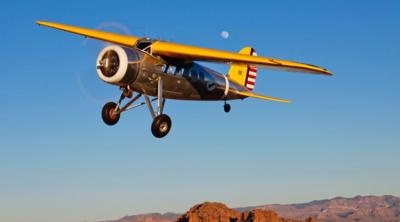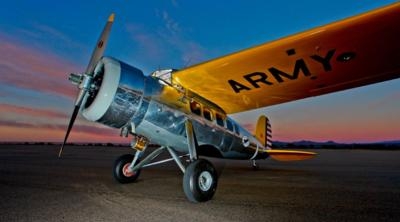Airplane Is '90 Percent Original', Its Restorer Says
Those who revel in rare aircraft are in for a real treat at EAA AirVenture Oshkosh 2014 as the world’s only flying example of the Lockheed’s history-making Vega, made famous by such aviation legends as Amelia Earhart and Wiley Post, flies to Wittman Regional Airport for the 62nd annual gathering scheduled for July 28-August 3.

John Magoffin, EAA 1003773, of Tucson, Arizona, will show his beautifully restored 1933 Lockheed Vega DL-1B to aviation enthusiasts from around the world who will truly appreciate its historical significance. Magoffin has put about 10 flying hours on NC12288 since its maiden post-restorative flight on December 17, 2013. That was the first time in more than two decades since a Vega had flown.
The six-passenger monoplane, serial number 161, is currently hangared at the Commemorative Air Force’s Air Base Arizona in Mesa.
“It’s a long way from Arizona to Wisconsin, but I’m really looking forward to it,” Magoffin said. Like the airplane, this will be his first visit to EAA’s annual summer gathering, and attendees can see the airplane prominently parked in front of the Vintage Red Barn just south of the EAA Plaza.
A total of 630 Vegas were built, and Magoffin’s is the only surviving example with an aluminum fuselage, built by the Detroit Aircraft Corporation (hence the DL model number for “Detroit Lockheed”). All other existing examples - including the one in which Amelia Earhart made the first trans-Atlantic solo flight by a woman, and the one Wiley Post flew around the world twice - are of wood construction. Those two aircraft are permanent fixtures at the Smithsonian Air & Space Museum.
Other surviving airframes include one owned by Kermit Weeks, one in the Henry Ford Museum, and one owned by John Desmond in Philadelphia that’s reportedly under restoration.
According to Magoffin, the airplane is 90 percent original, with a rebuilt wing and tail that was “in splinters.” It’s powered by a 450-hp Pratt & Whitney R-985 Wasp Junior engine turning a Hamilton Standard 2D3 twin-blade prop. The restoration was done by Arizona Airframe Service, Marana, Arizona.
The airplane was built in 1933 from spare parts, assembled by Lockheed’s chief engineer Richard Van Hake. Originally buyer was the Morrell Meat Packing Company of Ottumwa, Iowa, and the aircraft saw several other ownership changes over the years, including Braniff Airways, the Green Construction Co. of Sioux City, Iowa; Texas & Northern Airways; Northern Air Services of Fairbanks, Alaska; and Alaska Coastal Airlines. After a crash at Ruby, Alaska, NC12288 sat derelict for a number of years.

It wound up back in Ottumwa after being acquired by Robert Taylor, who got it airworthy again in 1969. It was sold to Mid-America Air Group and then was wrecked again in Frederick, Oklahoma. Magoffin bought the airplane in 1995 as “a basket case,” he said, with the three-year restoration project starting 15 years later, in 2010.
Magoffin’s airplane is painted in the colors that its sister ship (c/n 158) wore when it served with the 35th Pursuit Squadron out of Langley Field, Virginia, in 1932. This outfit is still serves as the 35th Fighter Squadron flying F-16s out of Kunsan, South Korea. Their squadron patch features the black panther as used in 1932.
That aircraft was the first Lockheed product acquired by the U. S. military (U.S. Army Air Corps.) A second Vega (c/n 159) was later acquired by the U. S. Army Air Corps, and fitted with a wire-braced landing gear for speed. Flown by Capt. Ira Eaker, it set an unprecedented speed record during an attempt to fly coast-to-coast. When Eaker was forced to make an emergency landing in Tolu, Kentucky, it was noted at the time that no aircraft had ever flown so far, so fast.
Magoffin flew as a bush pilot in Alaska in the Fairchild Pilgrim 100B, de Havilland Otters, and Stinsons, and later DC-3s and C-46s. He would like to have the airplane put to work for advertising, movies, and television promotions.
(Images provided by EAA)
 Aero-FAQ: Dave Juwel's Aviation Marketing Stories -- ITBOA BNITBOB
Aero-FAQ: Dave Juwel's Aviation Marketing Stories -- ITBOA BNITBOB NTSB Prelim: Rutan Long-EZ
NTSB Prelim: Rutan Long-EZ ANN's Daily Aero-Term (12.05.25): Hazardous Weather Information
ANN's Daily Aero-Term (12.05.25): Hazardous Weather Information Aero-News: Quote of the Day (12.05.25)
Aero-News: Quote of the Day (12.05.25) Airborne-Flight Training 12.04.25: Ldg Fee Danger, Av Mental Health, PC-7 MKX
Airborne-Flight Training 12.04.25: Ldg Fee Danger, Av Mental Health, PC-7 MKX




